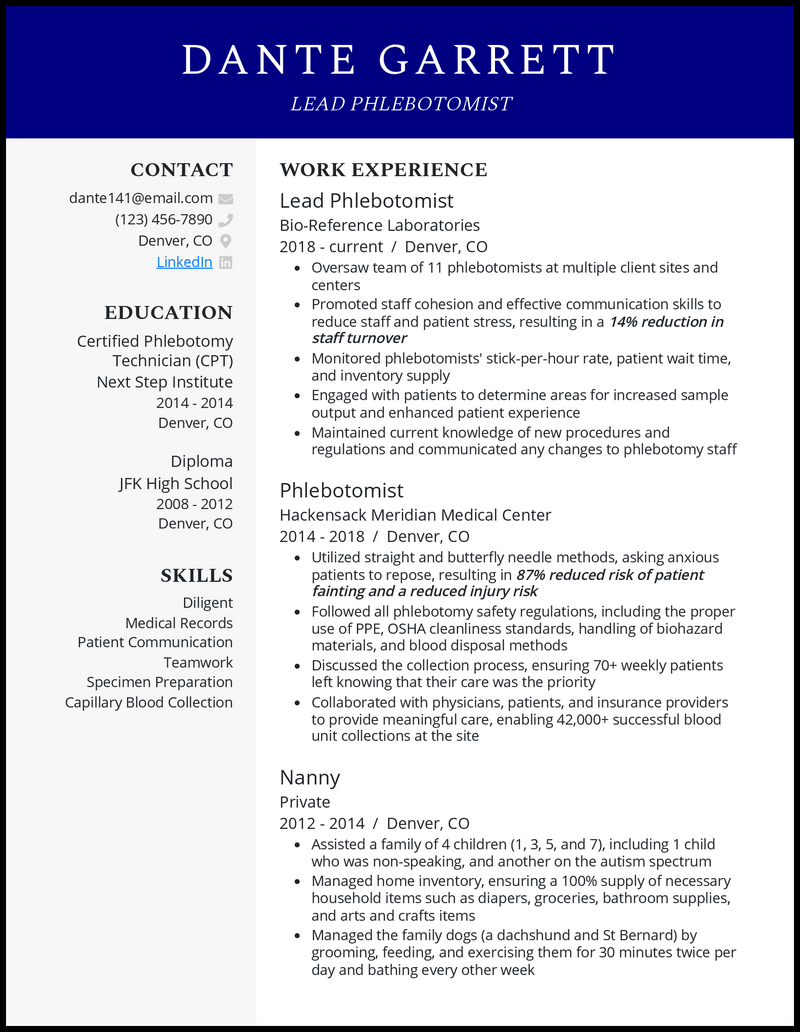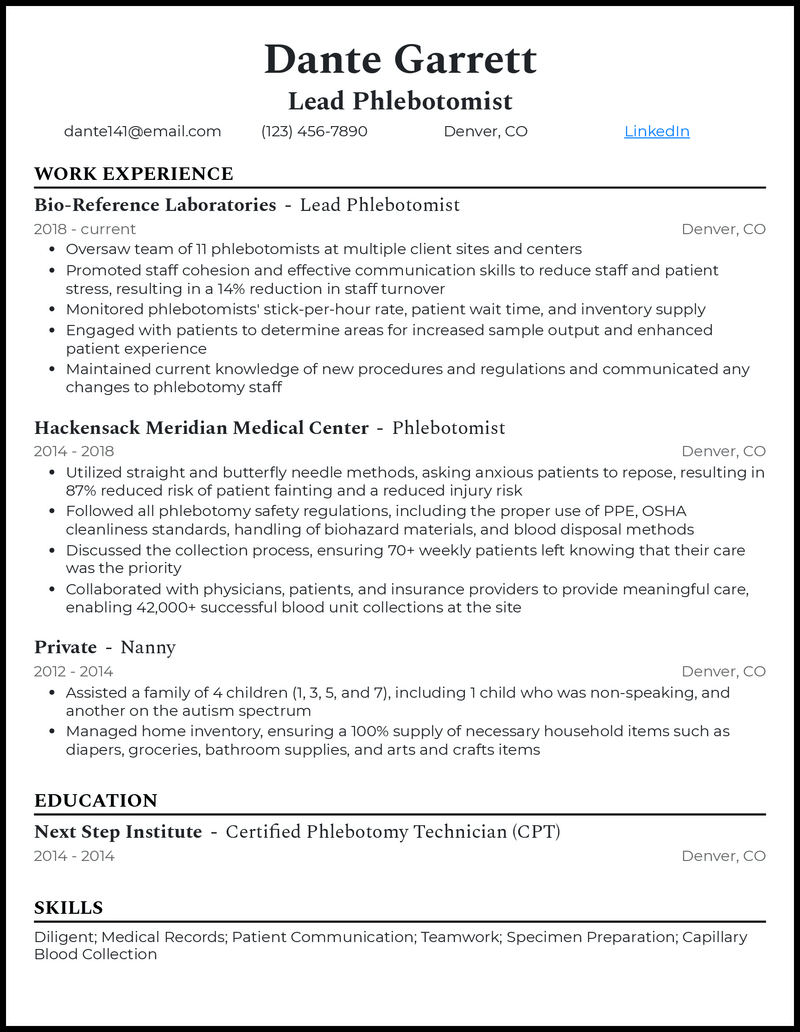Anyone who gets their blood drawn wants to feel like they’re in good hands. You ensure an excellent patient experience with friendly care, top safety practices, and managing employees effectively.
Is your resume template ready for the challenge as you take the next step in your phlebotomy career?
Every medical organization wants to ensure they hire knowledgeable professionals, and that starts with reviewing the top skills listed on resumes. We’ve put together some effective lead phlebotomist resume examples to give you the best chance of standing out.
Related resume examples
What Matters Most: Your Lead Phlebotomist Skills & Work Experience

You know that performing comprehensive blood draws requires a great deal of skill and precision. Everyone’s vascular structure is different, and some patients may have bad experiences with needles. Having the right skills to manage it all is essential.
As a lead phlebotomist, you’ll want to emphasize leadership and technical abilities to stand out. You can get some good ideas by reviewing the top industry skills and analyzing what the company is looking for in the job description.
For instance, facilities that offer outpatient procedures would want to see how you can coordinate employee schedules when they need to navigate to different locations.
Here are some of the top industry lead phlebotomist skills in 2025.
9 top lead phlebotomist skills
- Puncture Site Selection
- Puncture Site Warming
- Team Leadership
- Sanitization
- Protective Equipment
- Blood Pathogen Control
- Toxic Waste Control
- Specimen Preparation
- Medical Records
Sample lead phlebotomist work experience bullet points
Before putting you in a leadership position, organizations will want to see how you’ve applied your phlebotomy skills in past jobs.
Using examples you can quantify is a great way to stand out. Consider metrics like how many patients you worked with, satisfaction scores, and record accuracy.
Additionally, be mindful that not every hiring manager who looks at your resume will have as much phlebotomy knowledge as you. Avoiding too many comprehensive details in aspects like blood-borne pathogen control helps make your examples understandable for anyone. For instance, you could say you managed blood-borne pathogens for five years without errors.
Here are a few samples:
- Complied with all recording and labeling procedures to reduce unusable sample rates by 35%.
- Explained procedures in a calm and friendly manner to all patients, leading to 68% higher satisfaction scores.
- Used proper puncture site warming and tourniquet application to reduce post-procedure pain by 86%.
- Instructed nervous patients to lie down to reduce the chances of fainting by 75%.
Top 5 Tips for Your Lead Phlebotomist Resume
- Use proper formatting
- Reverse chronological formatting is the best fit for lead phlebotomists. You’ve likely grown your skills over your career, so listing your most recent experiences first will show your most comprehensive abilities in aspects like toxic waste management and specimen preparation.
- Use numbers whenever possible
- Metrics help illustrate the impact you have on the patient experience. For example, saying you “updated medical records with 99% accuracy for six years” sounds more impactful than simply stating you “managed medical records.”
- One page is the best length
- Limit your resume to a concise and relevant page of information. If you’re wondering what’s most important, try narrowing in on what the organization lists in the job description. For instance, if they need help enforcing OSHA standards, your sanitization skills and protective equipment knowledge would be essential.
- Both leadership and technical ability are important
- In the lead role, you’ll be in charge of a full phlebotomy team. Therefore, focusing on aspects like scheduling, employee relations, and comprehensive venipuncture skills will all be essential to show you have the right abilities.
- Have your cover letter and resume work together
- You have a lot of experience that may not all fit on your resume. However, you can go into more detail in your cover letter about how you ensure a great patient experience and help your team manage specimens with high levels of accuracy.
Phlebotomy professionals with ten or more years of experience will benefit from a resume summary. You could write a few sentences on how you’ve performed blood draws on over 950 patients annually with 98% positive satisfaction scores over your 11-year career.
Try to find examples where you’ve shown leadership in the past. For instance, if you trained team members on a new patient record filing system that improved accuracy by 79%, that would be ideal to include.
Try to have a measurable example for each skill you list on your resume. For example, if you list puncture site selection, you could include an example of how you use warming techniques to make site selection 97% more accurate.








